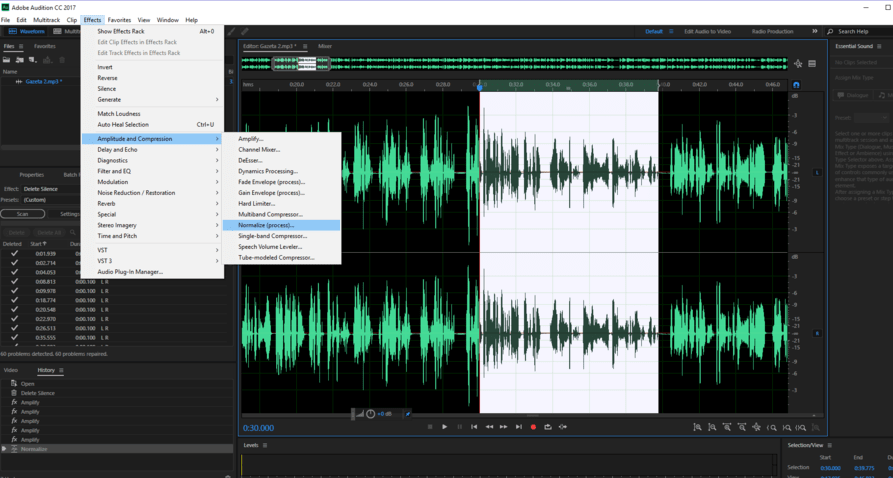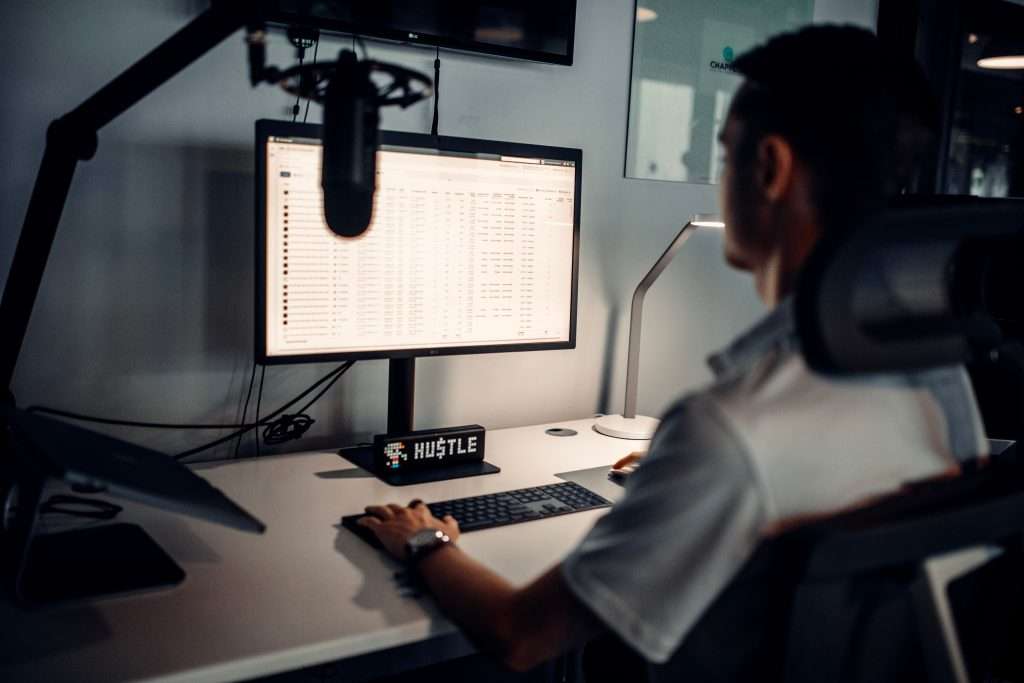
Starting a podcast for a company is getting really popular. You will probably know this already since you’ve found this article. Let’s be honest, content is always king when it comes to great podcasting. However, the editing of a podcast can greatly reduce the quality of your story if you don’t understand the principles of great podcast editing. When you’re starting a podcast for your company, these four things are essential when
- What’s your story?
- Who do you need to talk to?
- What equipment do you use?
- How do you structure a cohesive story?
- What program and plug-ins do you use for editing?
- Where do you post
Recording the rough audio file
Assuming you have the equipment available, you will always start by recording the conversation. If you don’t know what microphones you need to buy, here is a great article about the best microphones. You don´t need a lot of post-processing when you’re placing the microphones correctly before the conversation starts. However, in this article we do not go into it much. If you want to get the best results from a microphone, read this article about the proximity effect.
Cutting the audio of the file
Before you start a podcast for your company, it’s best to listen to the podcast in its entirety. This feels superfluous but it will surprise you how important it is to see the big picture in front of you first. Especially when you need to edit large quantities of content. So how do you effectively structure a large podcast? With a long form podcast, we personally use Sonix.ai; a speech-to-text editor that we use for the companies for which we edit podcasts. With their timestamps and accurate text documents it’s easier to make a cohesive story before you start cutting all the audio files.
The roadmap of great podcast editing for companies
- Get a notepad and write down the striking things in the recordings. For example, specific moments that were good and things that were maybe a bit less interesting in the recording.
- Look at the audio file and removes large silences and loud sudden noises or cracks in the recording. For example, people that are drinking around the microphone, people go to the toilet or accidently hitting the table.
- When the audio plays, listen to the rhythm of the person who talks. Some podcast guests are natural speakers, and for some it is a little more difficult (which is totally fine by the way!). When you want to further clean the audio and get permission, you can try to remove the “superfluous” information, such as many silences, “uhm’s” or repeated sentences.
- It is probably best to edit the rhythm of the podcast as little as possible. Especially when the podcast guests are natural speakers and who come out of their words well. But we can assure you, our podcast editors have edited hundreds of podcasts for companies and can guarantee you that this is so much more difficult than it seems at first sight.
Mixing the podcast for your company.
So now we have an edit of our podcast. The structure is set, and right content is in place. Now our editor can optimize the podcast so it’s publish-ready for our companies. Usually this is the part where non-professionals miss the mark. This mixing stage should be very structured, so you don’t worsen the audio quality. Especially audio that doesn’t have the best quality (i.e. blowing wind, crowd noises) should be handled carefully.
To make this stage more visual, compare editing the audio material to cooking. The previous steps were mainly the cutting stage. Doing the groundwork so you have a good base so that all the main ingredients are in place. Think of the mixing stage as the spice rack where you can use spices to “spice” up the audio. When you listen to a great podcast of a company that’s getting you sucked in, it’s probably thanks to a podcast editor that had a great ear for mixing voices and music.
There are a few Virtual Studio Technologies (VST) that we use on a daily basis.

- Compression (Compression)
- Equalizer (EQ)
- Noise reduction (noise reduction)
There are many more possibilities, but these are the most important things when editing a podcast. If these terms sound unfamiliar, let’s give them all a brief description and its function.
Equalizer
EQ is being used in almost every recording our podcast editor edits for our companies. EQ stands for Equalizing and is used to cut or boost specific frequencies in the sound. For example, when a podcast recording has a lot of bass, you can cut those frequencies out, so you have less rumbling. Or if you have a recording that sounds muffled, you can turn up the high frequencies to hear more detail in their voices. It can also be used very precisely to remove specific frequencies that are unpleasant for the ear.
Graphically, you can represent the sound as a horizontal line with the lowest frequencies on the far left and the highest frequencies on the far right. The vertical axis determines the strength of the sound in decibel (dB). Equalization allows you to boost this horizontal line by making it drop or raise it at certain points on the spectrum.
Compression
Compression is probably the most difficult VST to explain well to a layman. You find many professionals that find it difficult to explain this to others. Hope we do it justice so that you have a better understanding of compression and edit your own podcast the best way possible.
To put it simply, compression reduces the dynamic range of a specific audio track by lowering the volume level of the loudest parts and moves them closer to the softer segments of the track. By doing this, you have fewer variations in volume, from the microphone to the final product.
After reading still don’t fully understand the principles of compression? Our podcast editor company is always happy to ellaborate and advise you on your podcast journey. Give us a message and we’ll get in contact with you today!
Threshold
The most important knob on a compressor is the threshold. With this knob you are able to set a limit to when the compression should take place or not. So, if the threshold is set to 0 dB, then no compression will take place. However, if you set the limit to 5 dB, all audio above that level will be compressed according to the settings, it kind of limits the louder parts to take place and blends them in with the softer sounds.
Ratio (the ratio)
When we talk about “ratio”, what we mean is how much we want the audio to be compressed above the threshold. The difference between threshod and ratio is that the threshold determines when the compression should take places, where the ratio determines how much compression should take place when the threshold is reached.

An example:
The lowest possible ratio is 1: 1, this means that no compression is applied.
2: 1 means that for every 2 dB the signal comes above the threshold, the compressor is delivering 1 dB output. This makes the noise quieter and more equal to the rest of the track.
When you use a ratio of 4: 1 you can determine the result in a similar way. For every 4 dB that the signal comes above the threshold, the compressor gives 1 dB output. The podcast editor company uses this for the podcasts of our companies to get a great and even sounding episode.
Attack / Release
The attack on a compressor is used to determine how quickly the compressor responds when the signal exceeds the threshold. While release, on the other hand, determines how quickly the original volume is back to normal when the signal returns below the threshold level after it was activated.
Noise Reduction
Noise reduction is self-explanatory. It reduces constant background noises, such as hum and buzzing, hissing etc. Our podcast editor company use Adobe Audition for our companies as their noise reduction tool is the best on the market, but you have lots of free options. Audacity has a great noise reduction tool which could dramatically improve your podcast.
To use noise reduction properly, you need to select a region in the sound wave (i.e. the audio file) that only contains the noise that you want to reduce. This means even someone breathing in the background. These noise reduction tools are amazing, but they could be very delicate to handle if not used properly.
Keep in mind that it can be impossible to get a satisfactory removal if the background noise is very loud or blends with the speaking voices. If the background noise is too loud, it can result in muffled conversations which sound heavily edited and unnatural.
This process relies on computer calculation so if you want to know more about it, you can find the entire process here.
Podcast music – made by professional musicians or music libraries?
There are a lot of places where you can get podcast music for free which isn’t original podcast music. Of course, for many podcasters it is good enough to use music coming from music libraries. However, it isn’t possible to make any adjustments when you want to emphasize certain parts in the song. It doesn’t matter if it’s the intro jingle or the background music. If you truly want a great podcast that is intertwined with its music, you want a professional musician to create their own auditorily world. What is our pricing?
A great example for a podcast that does this extremely well is 99% Invisible. They have in house podcast musicians that create their music to all fit in the 99% invisible universe. Besides the amazing content they create, the music all blends in so well together. Another podcast who has incredible music in the background is Twenty Thousand Hertz. This podcast is probably our favorite sonic world, they put a lot of effort in their content but most of all their music. Again, these podcasts are wonderful to listen to but what if you’re having a growing podcast yourself? It’s difficult to find freelance podcast musicians because most of them work at larger firms such as Defacto Sounds.
We can create your sonic brand for every story, every podcast and every channel. We have multiple freelance sound engineers and podcast editors to create your sonic brand and edit your podcast all at once. It’s understandable that your company doesn’t need a unique composition for every podcast but we can make sonic packages which you can reuse every single time, no reoccurring costs, just a one-time purchase.
What is our work process?
We understand that a lot of podcasters don’t necessarily need a sonic brand with multiple audio files. For these podcasters we make singular podcast jingles that are uniquely made for your company only. As one of the few podcast editors in Europe, we make original podcast music for our customers. This music is not used by anyone else and is completely tuned to the character of the company.
- We will contact you after completing the form.
- When we have got acquainted, we ask what your company stands for.
- We also ask for some references of what original podcast music you appreciate.
- We get to work and within a few days you will receive 2 or 3 jingles.
- A choice is made and the jingle is yours from that moment on!
